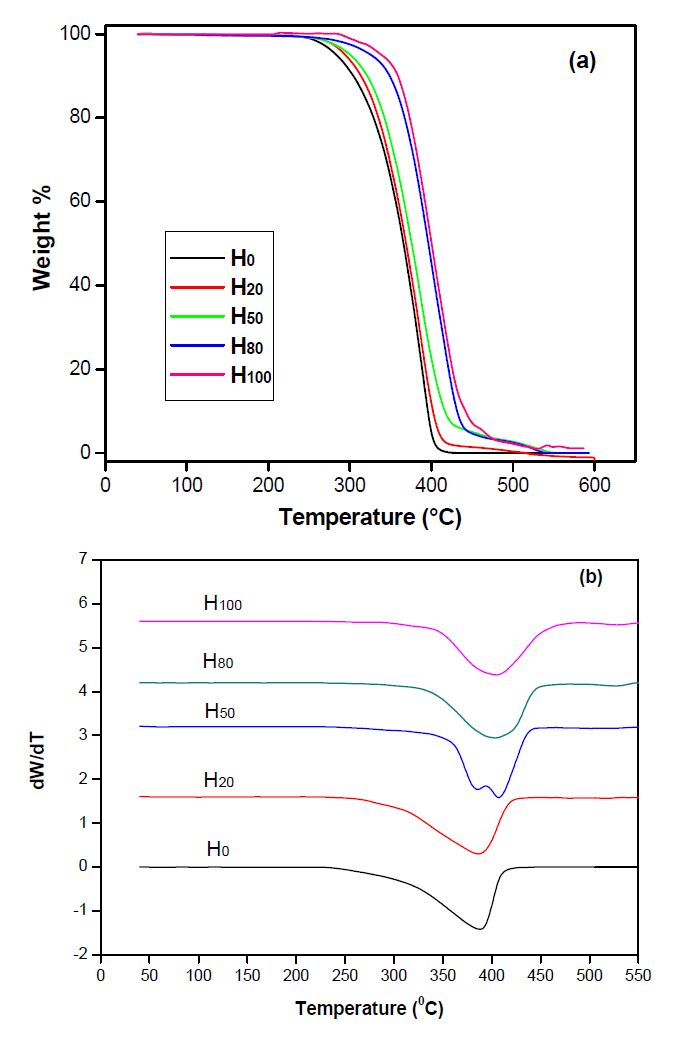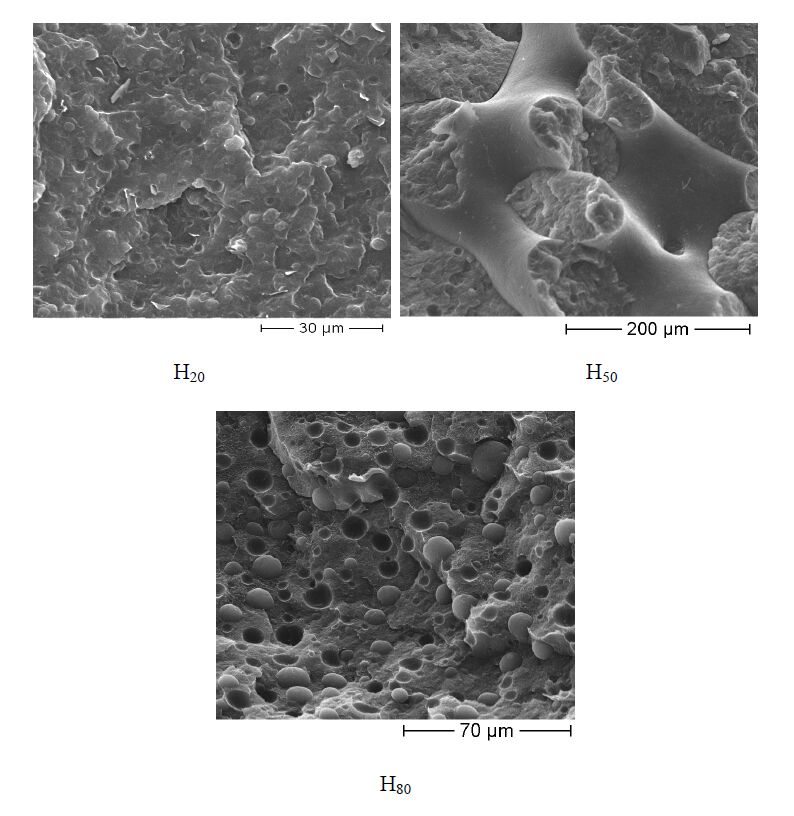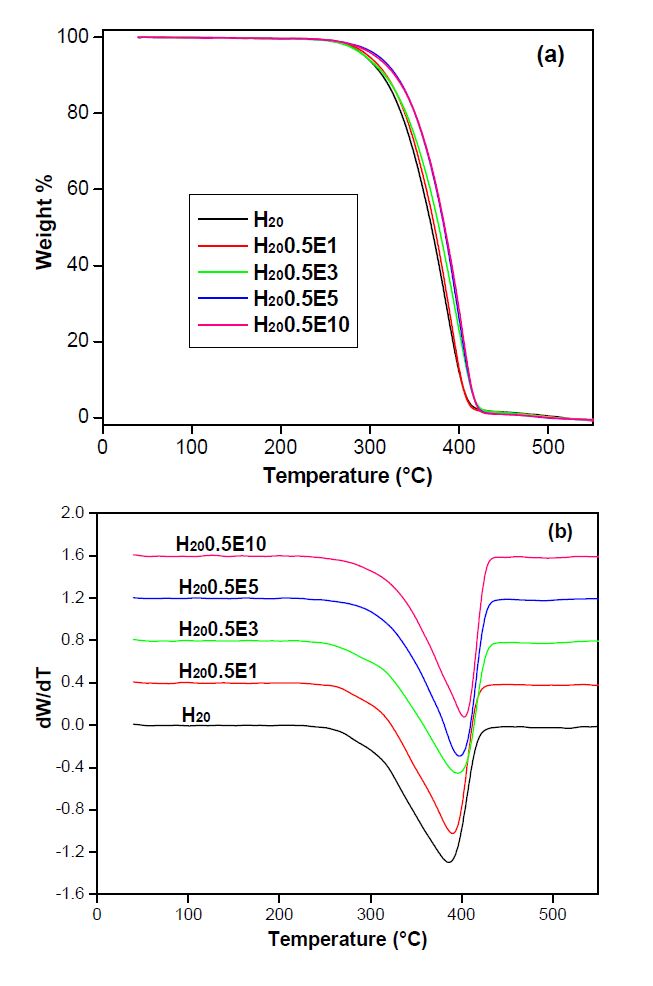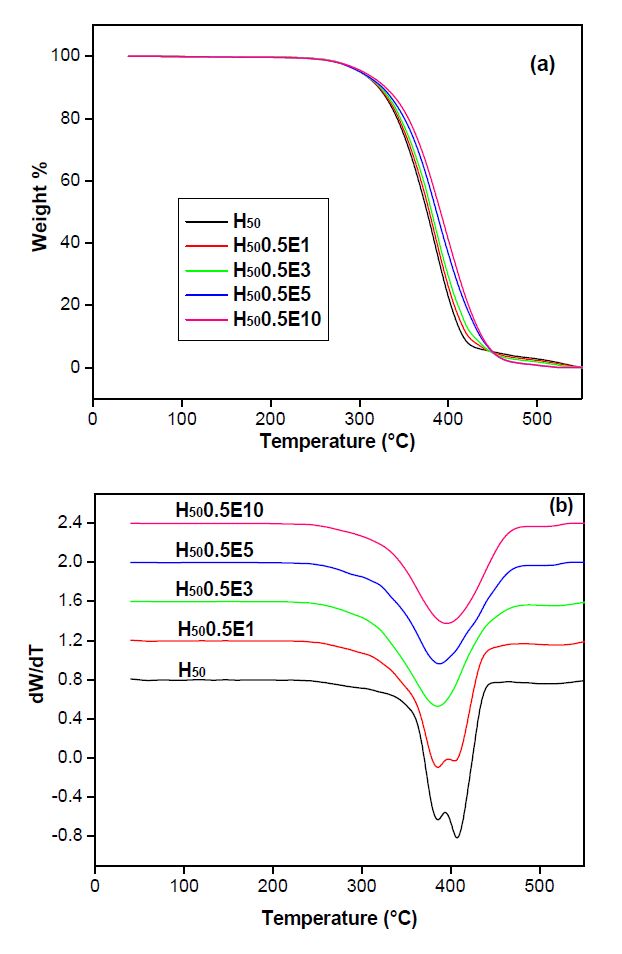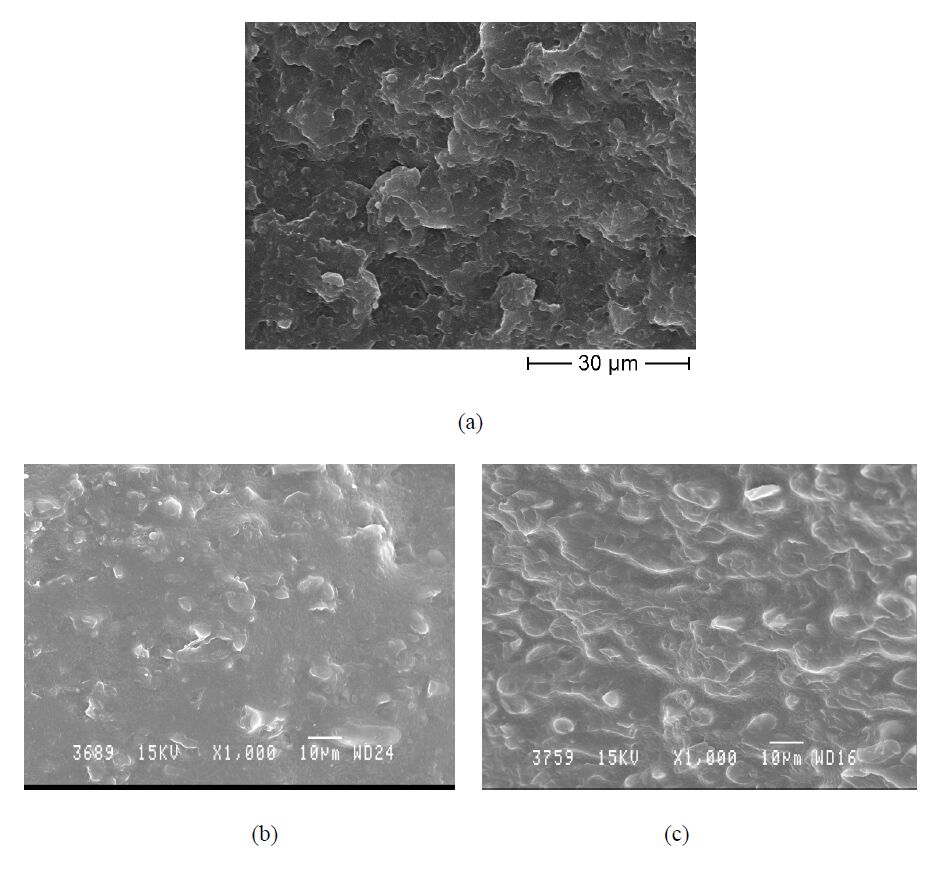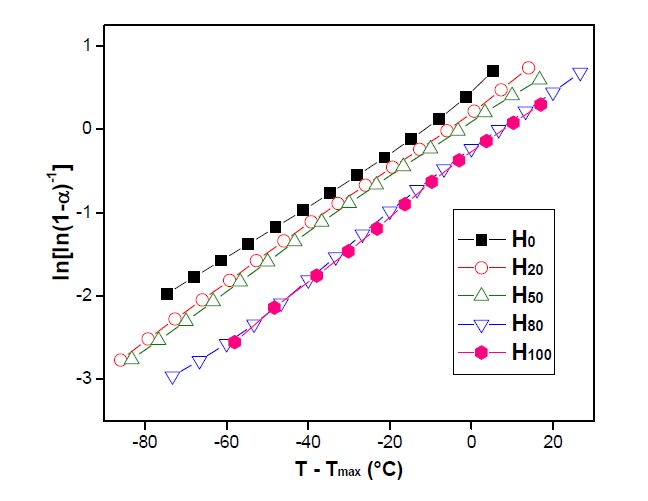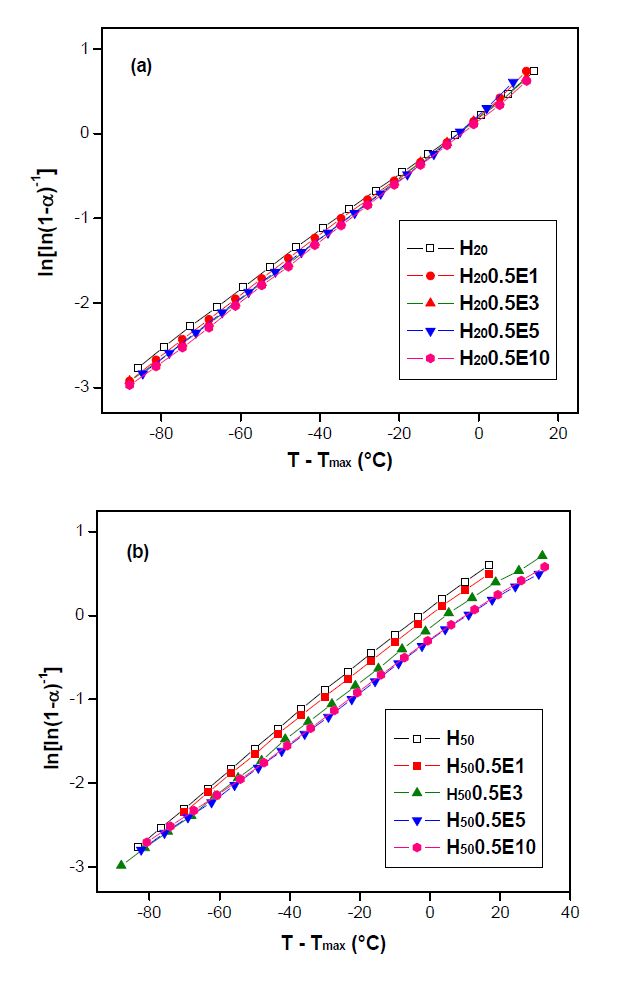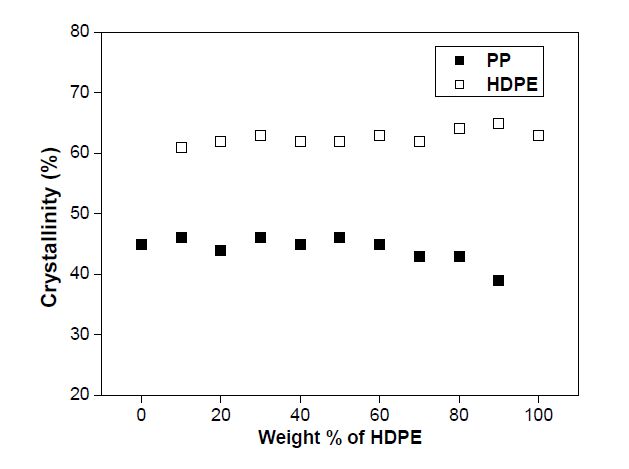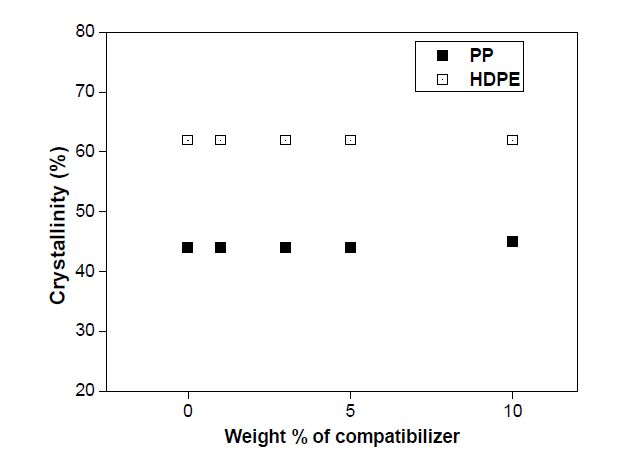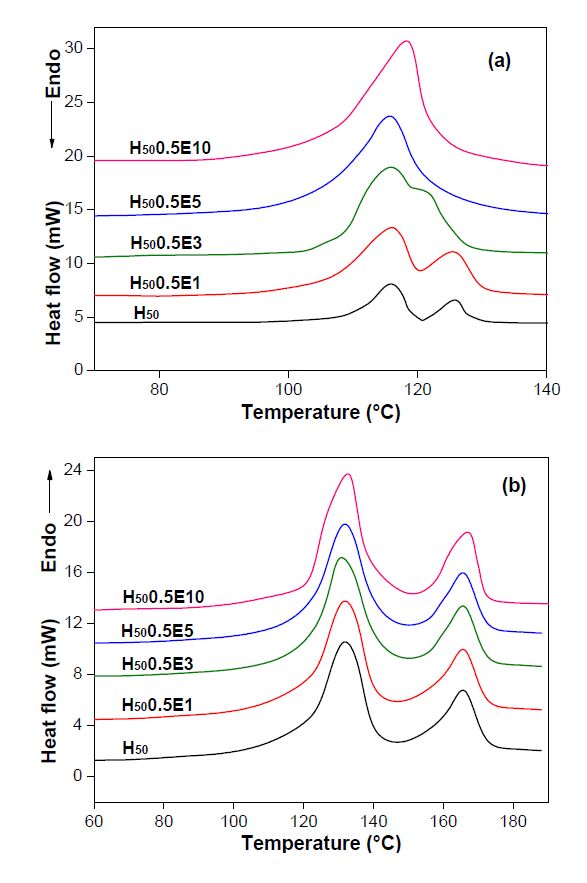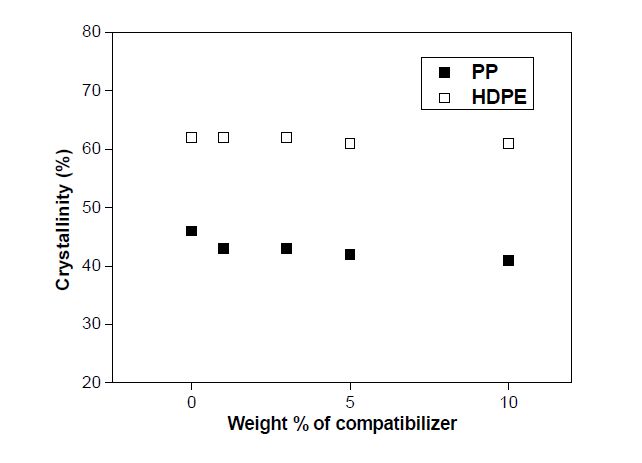1. Introduction
Thermal degradation and crystallization characteristics of polymer blends are very relevant to the potential use of them in many applications. Thermal degradation properties are important because thermal stability of polymeric materials is one of the principal criteria for designing these materials for demanding applications [1]. Fabrication and design of a variety of articles with improved thermo-mechanical properties require a comprehensive understanding of the degradation behaviour of polymers, because the threshold temperature for degradation decides the upper limit of the fabrication temperature. It is unequivocally established that polymer blending has great impact on the thermal stability of polymer blends [2,3,4,5,6,7,8,9]. Compatibility between the components in a polymer blend is one of the decisive factors, which regulates the thermal stability of polymer blends. Moreover, it has been reported that compatibilization has profound influence on the thermal stability of multi-phase polymer systems [10,11,12,13,14,15,16].
Several researchers have shown that blending of polymers has significant effect on the crystallization characteristics of component polymers [17,18,19,20,21,22,23,24,25]. Incorporation of a second polymer into a semi-crystalline polymer may lead to (a) no change in the crystallization process [26,27,28] (b) retardation of crystallization rate [29,30] or (c) suppression or inhibition of crystallization [31,32], depending on the nature of the second component and crystallization conditions. Although a compatibilizer has a remarkable influence on the morphology of the blends, it may or may not affect the melting and crystallization characteristics [13,29,33,34,35]. Some researchers reported that incorporation of compatibilizer influences the melting and crystallization parameters of semi-crystalline polymers [29,36,37,38,39,40,41]. However, other studies have shown that unless a compatibilizer imparts molecular level miscibility, crystallization process will not be affected [13,18].
In this paper, we investigate the effect of blend composition and compatibilization on the thermal degradation characteristics and crystallization behaviour of polypropylene/high density polyethylene (PP/HDPE) blends. Thermal stability and degradation properties have been analysed by thermogravimetric method. Differential scanning calorimetry (DSC) has been employed to determine the crystallization behaviour of the blends. The activation energy for degradation was computed using Horowitz-Metzger equation. Attempt has also been made to correlate thermal degradation and crystallization characteristics of the blends with their morphology and phase structure.
2. Materials and Method
2.1. Materials
Isotactic polypropylene, PP-Koylene 3060, (MFI of 3 gram per 10 min and density of 905 kgm−3) was obtained from Indian Petro Chemicals Limited, Baroda, Gujarat, India. High density polyethylene (HDPE-Relene, M60 200), having an MFI of 20 gram per 10 min and density of 960 kgm−3, was supplied by Reliance Industries, India. The compatibilizer, ethylene propylene diene terpolymer (EPDM), with monomer ratio of approximately 0.5, was obtained from Herdillia Unimers Ltd., Mumbai, India.
2.2. Blend Preparation
Various compositions of PP/HDPE blends were prepared by melt-mixing at 175°C, in a Brabender Plasticorder. The rotor speed and mixing time were optimised as 60 rev·min−1 and 5 min, respectively. Table 1 gives the coding system used to represent various uncompatibilized blends. Compatibilized blends were prepared by two-step mixing. First, the compatibilizer was pre-mixed with the minor component and melted for two min at 175°C. It was followed by the addition of the major component and mixing was continued for another 5 min, at a speed of 60 rev·min−1 at 175°C. For compatibilized blends, each code contains three parts: first refers to the blend, second to the compatibilizer and the third part indicates the concentration of compatibilizer in the blend with respect to the minor phase. For example, in H200.5E1, H20 refers to the blend composition (here 80 wt% PP and 20 wt% HDPE), 0.5E denotes the EPDM (0.5 indicates that E/P ratio is approximately 50:50) and 1 denotes the concentration of EPDM. The melt-mixed samples were compression-moulded at 185°C to obtain sheets of 2 mm thickness.
Table 1.The coding system of uncompatibilized PP/HDPE blends.
| Blend | HDPE (wt%) | PP (wt%) |
| H0 | 0 | 100 |
| H10 | 10 | 90 |
| H20 | 20 | 80 |
| H30 | 30 | 70 |
| H40 | 40 | 60 |
| H50 | 50 | 50 |
| H60 | 60 | 40 |
| H70 | 70 | 30 |
| H80 | 80 | 20 |
| H90 | 90 | 10 |
| H100 | 100 | 0 |
2.3. Phase Morphology Studies
The morphology of cryogenically fractured surface of the blends was analysed using a Jeol Scanning Electron Microscope (SEM; Jeol 5400, Tokyo, Japan). Before analysis, the samples were sputter-coated with gold.
2.4. Thermogravimetric Analysis
The thermal degradation studies of the blends were done in a Mettler TG 50. The samples of mass approximately 10 mg were scanned from 25°C to 600°C at a heating rate of 20 K/min. From the TG curves, thermal degradation characteristics such as onset of degradation (Ton), temperature at maximum rate of degradation (Tmax), temperatures at different weight losses and integral procedural decomposition temperature (IPDT) have been calculated. Activation energy for degradation (Ea) was calculated using Horowitz-Metzger (HM) equation.
2.5. Differential Scanning Calorimetry
The melting and crystallization characteristics of the blends were determined using a Mettler 820 DSC thermal analyser. The mass of the sample taken for the measurement was approximately 10 mg. The first heating was done from 25°C to 200°C at a rate of 40 K/min, followed by isothermal heating for 3 min. The first cooling and second heating were performed at 10 K/min, in nitrogen atmosphere. The melting and crystallization characteristics were determined from the DSC heating and cooling curves, respectively. Crystallization temperature (Tc), melting point (Tm), normalised enthalpy of crystallization (DHc), normalised enthalpy of fusion (DHf) and percentage crystallinity (X%) have been computed. The normalised values have been calculated with respect to the weight fraction of the corresponding component. The X% was estimated from the DHf, using the following equation:
|
X%=(ΔHf,normΔHf100)×100
|
(1)
|
where ΔHf100 is the enthalpy of fusion of 100% crystalline polymer. ΔHf100 of PP and HDPE was taken as 209 and 290 J/g, respectively.
3. Results and Discussion
3.1. Thermal Degradation Properties
3.1.1. Uncompatibilized Blends
The effect of blend composition on the thermograms (TG) and derivative thermograms (DTG) of PP/HDPE blends is given in Figure 1. A detailed evaluation of the thermograms is presented in Table 2, which gives an idea about the effect of blend composition on the temperature corresponding to different weight losses (viz. Ton—onset of degradation, T10—temperature corresponds to 10 wt% degradation, and so on), Tmax and IPDT. It is seen from the table that PP is more susceptible to degradation whereas HDPE shows maximum thermal stability. The Ton of PP (286°C) is much lower than that of HDPE (345°C). Thermal stability of the blends lies in between these limits. As the amount of HDPE in the blends increases, thermal stability increases. For example, the Ton of PP increases from 286 to 297°C by the addition of 20 wt% of HDPE (H20). However, it is important to point out that up to 50% addition of HDPE into PP (H50), Ton increases by ca. 19°C and further addition of 30 wt% of HDPE into PP (H80) increases the Ton by ca. 30°C. (The same trend is seen in the case of T10, T20, etc.). This implies that phase morphology (Figure 2) has a decisive role in determining the thermal stability of the blends. It should be noted that in H20 blend, PP is the matrix while in H50 blend, both PP and HDPE form continuous phases. Thus in H20 and H50 blends, PP phase is more exposed to thermal degradation. On the other hand, in H80 blend, HDPE forms the matrix whereas PP the dispersed phase. As a result, HDPE matrix provides a certain level of protection to the dispersed PP phase.
Table 2.Effect of blend composition on the temperatures corresponding to different percentage weight losses, Tmax and IPDT of uncompatibilized PP/HDPE blends.
| Blends | Ton (°C) | T10 (°C) | T20 (°C) | T30 (°C) | T40 (°C) | T50 (°C) | Tmax (°C) | IPDT (°C) |
| H0 | 286 | 307 | 328 | 345 | 356 | 365 | 388 | 356 |
| H20 | 297 | 314 | 334 | 347 | 360 | 370 | 387 | 362 |
| H50 | 305 | 322 | 338 | 353 | 364 | 376 | 390 | 374 |
| H80 | 335 | 350 | 367 | 378 | 386 | 395 | 407 | 397 |
| H100 | 345 | 356 | 373 | 384 | 393 | 401 | 408 | 406 |
IPDT has been employed to assess the relative thermal stability of blends under the procedural conditions. IPDT of the blends was measured using Doyle’s method [42] given as:
where Ti and Tf are the initial and final experimental temperatures, A* is the ratio of area under the curve and the total area of the thermogram and K* is the coefficient of A*. Note that there is big difference between the Tmax and IPDT of PP (ca. 32°C) whereas the difference is negligible for HDPE (ca. 2°C). As the amount of HDPE in the blend increases, the difference between Tmax and IPDT decreases. Even though both Tmax and IPDT give similar information, both are derived in different ways and in the case of completely degradable polymer systems, IPDT is more dependable since it is derived from systematic calculations. An increase in the value of Tmax and IPDT indicates improvement in thermal stability. It is obvious from the table that as the amount of HDPE in the blend increases, thermal stability increases. A clear picture is obtained from IPDT, which shows a regular trend. Similarly, the extent of increase of both Tmax and IPDT is different. It is also important to note that a correlation can be made between these parameters and morphology. Note that up to 50 wt% addition of HDPE into PP (H50), increase in Tmax (2°C) and IPDT (18°C) is not very significant, but beyond that there is considerable increase in both the parameters. For example, if the amount of HDPE in the blend increases from 50 wt% (H50) to 80 wt% (H80), Tmax increases by 17°C whereas IPDT shows an increase of 23°C. This gives a clear indication of phase inversion. In essence, addition of HDPE into PP increases the thermal stability of the blends. In addition, thermal stability of the blends depends on the phase morphology. Moreover, the extent of improvement in thermal stability depends on the nature of morphology.
3.1.2. Compatibilized Blends
Effect of compatibilization on the thermal stability of PP/HDPE blends can be derived from the TG and DTG curves given in Figures 3 and 4. The data derived from the figures are depicted in Tables 3 and 4. Table 3 displays the effect of compatibilization on the thermal stability of H20 blends and Table 4 that of H50 blends. It is seen from the tables that compatibilization has remarkable impact on the thermal stability of the blends. For example, with the addition of 10 wt% of the compatibilizer, the Ton of H20 blend increases by ca. 13°C whereas that of H50 blend by ca. 12°C. A similar observation is seen in all cases. The Tmax and IPDT provide same idea. In the presence of 10 wt% of compatibilizer, Tmax of H20 blend increases by 15°C and IPDT increases by 13°C. On the other hand, for H50 blend, there is only marginal increase in Tmax (4°C). This does not imply that there is no compatibilizing action. This is basically because H50 blends show two degradation peaks in the absence of compatibilizer (Figure 4b), corresponding to the degradation of PP and HDPE. It is worth noting that with the addition of compatibilizer, the peaks merge together to give a single one. This occurs when the concentration of compatibilizer is only 3 wt%. The merging of peaks may be considered as a type of“co-degradation”. Furthermore, it can be taken as an implication of compatibilizing action. But it is worth emphasizing that when the peaks merge together, the resultant peak is shifted towards the Tmax of PP. This is the reason why there is no significant increase in the Tmax of H50, in the presence of compatibilizer. On the other hand, IPDT shows an increase of 13°C. In summary, addition of compatibilizer has profound positive impact on the thermal stability of the blends. The improvement in thermal stability is mainly due to: (a) improvement in the interfacial adhesion between the components in the blends (b) reduction in the interfacial tension (c) regulation of the rate of coalescence and (d) stabilisation of the phase morphology of the blends [15,17,34].
Table 3.Effect of compatibilization on the temperatures corresponding to different percentage weight losses, Tmax and IPDT of H20 blends.
| Blends | Ton (°C) | T10 (°C) | T20 (°C) | T30 (°C) | T40 (°C) | T50 (°C) | Tmax (°C) | IPDT (°C) |
| H20 | 297 | 314 | 334 | 347 | 360 | 370 | 386 | 362 |
| H200.5E1 | 300 | 317 | 336 | 354 | 364 | 371 | 388 | 363 |
| H200.5E3 | 302 | 318 | 341 | 358 | 369 | 378 | 395 | 372 |
| H200.5E5 | 308 | 328 | 351 | 364 | 375 | 383 | 398 | 374 |
| H200.5E10 | 310 | 327 | 349 | 364 | 373 | 382 | 401 | 375 |
Table 4.Effect of compatibilization on the temperatures corresponding to different percentage weight losses, Tmax and IPDT of H50 blends.
| Blends | Ton (°C) | T10 (°C) | T20 (°C) | T30 (°C) | T40 (°C) | T50 (°C) | Tmax (°C) | IPDT (°C) |
| H50 | 305 | 322 | 338 | 353 | 364 | 376 | 390 | 374 |
| H500.5E1 | 307 | 322 | 341 | 358 | 370 | 378 | 390 | 375 |
| H500.5E3 | 310 | 324 | 343 | 360 | 373 | 380 | 388 | 378 |
| H500.5E5 | 314 | 328 | 349 | 364 | 377 | 386 | 389 | 382 |
| H500.5E10 | 317 | 329 | 353 | 370 | 379 | 390 | 394 | 387 |
Effect of compatibilizer on the matrix/droplet morphology of H20 blend can easily be evaluated from the SEM micrograph given in Figure 5a, because there is significant decrease in dispersed particle size. The effect of compatibilizer on the co-continuous morphology of H50 blend can be evaluated by comparing the SEM micrographs of annealed samples (annealed for 60 min at 180°C) shown in Figures 5b and 5c. Morphologies of uncompatibilized and compatibilized H50 blends are quite different after annealing. It is important to note that the co-continuous morphology of uncompatibilized H50 blend is unstable and is partially converted to matrix/droplet morphology on annealing. On the other hand, H50 with 3 wt% compatibilizer exhibits morphological stability as there is no change in the co-continuous phase structure on annealing.
It is well known that a compatibilizer improves the interfacial adhesion and facilitates the property transfer between the components [43]. This forces the polymer which degrades at a lower temperature to degrade at a relatively high temperature. However, the polymer which degrades at a higher temperature tends to degrade at a relatively low temperature. In effect, the presence of compatibilizer impels the degradation temperatures of the component polymers to come closer and increases the thermal stability of the blend. Note that the thermal stability of a multiphase polymer blend depends mainly on the thermal stability of the component which degrades at lower temperature. Thus, if the degradation temperatures of the individual polymers are nearer to each other, as in the case of PP and HDPE, there will be a type of“co-degradation”in the presence of compatibilizer, as observed in H50 blends.
3.1.3. Activation Energy for Thermal Decomposition
Activation energy for the decomposition of PP and HDPE in both uncompatibilized and compatibilized PP/HDPE blends was determined using Horowitz and Metzger (HM) method [44]. In HM method, activation energy was calculated using the equation:
|
ln[ln(1−α)−1]=Ea[Eaθ/EaθRTmax2]
|
(3)
|
where a is the decomposed fraction and is given as a=Ci−C/Ci−Cf, where C is the weight at temperature chosen, Ci is the weight at initial temperature and Cf is the weight at final temperature, Ea is the activation energy for decomposition, R is the universal gas constant and q is given by T−Tmax. Kinetic plots were made with ln[ln(1−α)−1] versus q. From the slope of the plots, Ea was calculated.
Figure 6 shows the Arrhenius plots for the activation energy for the decomposition (Ea) of PP and HDPE, in uncompatibilized PP/HDPE blends. The effects of blend composition and compatiblization on the Ea of PP and HDPE are given in Table 5. Ea of PP and HDPE are 118.3 and 145.3 kJ/mol, respectively. It is seen that addition of HDPE into PP increases the Ea of the blends. Although the blends are heterogeneous, only one Ea is reported for each blend. This is because it was difficult to resolve the degradation peaks of PP and HDPE in the blends into two, as there was no big difference in the temperatures for major degradation of PP and HDPE. In fact, two maxima were observed for H50 blend. Since the peaks were very close to each other, we considered the peaks as a single peak to avoid the complexity in calculating the Ea. This is the reason why H50 blend exhibits relatively lower Ea than expected. It is also important to note that an increase in Ea implies an improvement in thermal stability of the blends. Thus, it can be concluded that as the amount of HDPE in the blend increases, the thermal stability also increases.
Table 5.Effect of blend composition and compatibilization on the activation energy for degradation of PP/HDPE blends.
| Blends | Ea (kJ/mol) | Blends | Ea (kJ/mol) | Blends | Ea (kJ/mol) |
| H0 | 118.3 | H20 | 124.2 | H50 | 123.8 |
| H20 | 124.2 | H200.5E1 | 127 | H500.5E1 | 120.4 |
| H50 | 123.8 | H200.5E3 | 132.3 | H500.5E3 | 115 |
| H80 | 141.6 | H200.5E5 | 137.4 | H500.5E5 | 109 |
| H100 | 145.3 | H200.5E10 | 134.3 | H500.5E10 | 109 |
The effect of compatibilization on the Arrhenius plots for calculating the Ea for degradation of H20 blends is displayed in Figure 7a. It is obvious from table that addition of compatibilizer improves the Ea of H20 blends. This means that as the amount of compatibilizer increases, the tendency to undergo thermal decomposition decreases indicating improved thermal stability. However, in the presence of 10 wt% of compatibilizer, Ea slightly decreases. On the other hand, interestingly, Ea of H50 blends decreases in the presence of compatibilizer (Figure 7b). This is quite unexpected. However, attention should be paid to the fact that the degradation peaks of PP and HDPE merge together, in the presence of compatibilizer. This indicates that the degradation of both PP and HDPE occur simultaneously. From Figure 4b, it is clear that the degradation peak of the blend is shifted to the temperature corresponds to the degradation of PP (which has a lower Ea) indicating a type of“co-degradation”.
3.2. Melting and Crystallization Behaviour
3.2.1. Uncompatibilized Blends
It has been reported that the type of morphology and therefore blend composition has a crucial role in the crystallization behaviour of polymer blends [29,45,46,47,48,49]. Table 6 shows the effect of blend ratio on the Tc, Tm and the normalised values of DHc and DHf of PP and HDPE.
Table 6.Effect of blend composition on the crystallization temperature (Tc), melting temperature (Tm), normalised values of enthalpies of crystallization (∆Hc) and fusion (∆Hf)of PP and HDPE in uncompatibilized PP/HDPE blends.
| Blends | Tc (°C) | Tm (°C) | ∆Hc (J/g) | ∆Hf (J/g) |
| PP | PE | PP | PE | PP | PE | PP | PE |
| H0 | 126 | --- | 165 | --- | 96 | --- | 94 | --- |
| H10 | 128 | 118 | 166 | 131 | 98 | 177 | 96 | 175 |
| H20 | 128 | 117 | 166 | 130 | 94 | 185 | 91 | 179 |
| H30 | 127 | 118 | 165 | 132 | 95 | 179 | 96 | 181 |
| H40 | 127 | 119 | 166 | 131 | 99 | 178 | 95 | 179 |
| H50 | 126 | 118 | 165 | 132 | 94 | 182 | 97 | 178 |
| H60 | 125 | 117 | 164 | 130 | 95 | 181 | 93 | 180 |
| H70 | 126 | 118 | 164 | 133 | 93 | 185 | 90 | 178 |
| H80 | 125 | 117 | 163 | 133 | 92 | 185 | 90 | 183 |
| H90 | 125 | 117 | 163 | 130 | 83 | 187 | 81 | 186 |
| H100 | --- | 117 | --- | 132 | -- | 184 | -- | 180 |
The Tc of PP and HDPE are found to be 126 and 117°C, respectively, whereas Tm of PP and HDPE are observed as 165 and 132°C, respectively. It is seen that blend composition has no appreciable effect on the Tc and Tm of component polymers. This is not unexpected since PP/HDPE blends are immiscible and incompatible. As a result, the crystallization characteristics of individual components are little affected. It is observed from the table that ∆Hc and ∆Hf of PP are considerably less than that of HDPE. The percentage crystallinity of PP and HDPE is presented in Figure 8. The crystallinity of PE (ca. 62%) is greater than that of PP (ca. 45%). At the same time, it is important to note that there is no considerable change in the % crystallinity of components in their blends. In summary, the melting and crystallization characteristics of PP/HDPE blends reveal that blend composition has little impact on these properties due to the lack of specific interactions between the components signifying the immiscible nature of the blends.
3.2.2. Compatibilized Blends
The melting and crystallization characteristics of compatibilized H20 blends are summarised in Table 7.
Table 7.Effect of compatibilization on the crystallization temperature (Tc), melting temperature (Tm), normalised values of enthalpies of crystallization (∆Hc) and fusion (∆Hf) of PP and HDPE in H20 blends.
| Blends | Tc (°C) | Tm (°C) | ∆Hc (J/g) | ∆Hf (J/g) |
| PP | PE | PP | PE | PP | PE | PP | PE |
| H20 | 128 | 117 | 166 | 130 | 94 | 185 | 91 | 179 |
| H200.5E1 | 128 | 117 | 167 | 130 | 95 | 183 | 92 | 178 |
| H200.5E3 | 128 | 116 | 167 | 131 | 93 | 179 | 91 | 179 |
| H200.5E5 | 127 | 117 | 166 | 130 | 91 | 180 | 92 | 179 |
| H200.5E10 | 128 | 117 | 165 | 130 | 92 | 181 | 93 | 178 |
It is obvious from the table that incorporation of compatibilizer has no appreciable effect on the Tc and Tm of PP and HDPE. This implies that compatibilizer has no significant influence on the crystallization kinetics of polymer blends. Note that compatibilizer locates at the interface between the component polymers and decreases the unfavourable cross-correlations between them or increases favourable interactions. Since the physical compatibilizer stays only at the interface between the phases, there are only physical interactions between the components. These physical interactions do not lead to any type of miscibility or chemical bonds between the components. It is also observed that the DHc and DHf of PP and HDPE are also not considerably affected by the presence of compatibilizer even though there is marginal decrease in DHc and DHf values. Similarly, the percentage crystallinity of PP and HDPE are also little affected by the addition of compatibilizer (Figure 9).
The cooling and heating curves of compatibilized H50 blends are shown in Figures 10a and 10b, respectively (Note that the Y—axis of the heating and cooling curves is arbitrarily taken). Although the heating curves demonstrate no effect on the melting behaviour of the blends on compatibilization, the cooling curves provide some interesting observations. The cooling curves of compatibilized blends show a type of“co-crystallization”phenomenon, in the presence of compatibilizer. Note that with increase in the amount of compatibilizer, the two crystallization peaks approach each other and at 5 wt% of the compatibilizer, the two peaks merge together leading to“co-crystallization”behaviour. This indicates that in H50 blend, compatibilizer has a certain level of influence on the crystallization process.
The main difference between H20 and H50 blends is that in H20 blends, HDPE exists as dispersed domains in PP matrix whereas in H50 blends, both the phases are continuous. Thus in H50 blends, the crystallization process of each component may be affected by the presence of the other component (in the presence of compatibilizer). Joseph et al. [48] reported that spherulite growth of PP may change when matrix/droplet morphology changes to co-continuous, since the latter may slow down the crystal growth. On the other hand, in the case of blends with matrix/droplet morphology (H20), the crystallization process of the minor phase may be affected by the presence major phase. Note that PP crystallizes earlier than PE. This means that PP solidifies first so that in H20 blend, even if HDPE forms the dispersed phase, the crystallization process of HDPE is not affected by the presence of PP since during the crystallization process of HDPE, PP is in solid state. On the other hand, in the case of H50 blends, since it possesses co-continuous phase structure, the presence of HDPE phase affects the crystallization process of PP, which occurs earlier. But this happens only in the presence of the compatibilizer since in the absence of compatibilizer, the blends are highly incompatible and there is little probability for one component to interfere with the properties of the other. Thus in the presence of compatibilizer, the crystallization process of PP is suppressed by HDPE phase because PP solidifies in the vicinity of molten HDPE so that both the phases crystallize simultaneously near the Tc of HDPE (Table 8). Note that the resulting peak appears at ca. 116°C, which is the Tc of HDPE. This means that compatibilizer suppresses the crystallization of PP phase and enables the“co-crystallization”phenomenon to occur, near the Tc of HDPE. It should be noted that in the absence of compatibilizer, two distinct crystallization peaks correspond to PP and HDPE can be obtained.
Table 8.Effect of compatibilization on the crystallization temperature (Tc), melting temperature (Tm), normalised values of enthalpies of crystallisation (∆Hc) and fusion (∆Hf) of PP and HDPE in H50 blends.
| Blends | Tc (°C) | Tm (°C) | ∆Hc (J/g) | ∆Hf (J/g) |
| PP | PE | PP | PE | PP | PE | PP | PE |
| H50 | 126 | 118 | 165 | 132 | 165 | 132 | 97 | 178 |
| H500.5E1 | 124 | 116 | 166 | 133 | 166 | 133 | 90 | 178 |
| H500.5E3 | --- | 115 | 165 | 130 | 260 | | 89 | 177 |
| H500.5E5 | --- | 116 | 165 | 132 | 258 | | 87 | 175 |
| H500.5E10 | --- | 116 | 164 | 130 | 252 | | 85 | 174 |
Table 8 shows that the DHc values calculated from the area of crystallization peak is almost equal to the sum of the DHc’s of neat PP and HDPE. However, note that the DHf marginally decreases with increase in concentration of compatibilizer. Similar information is obtained from the Figure 11, which shows the effect of compatibilizer on the percentage crystallinity of H50 blends. In essence, it can be presumed that despite compatibilization has no significant role on the melting behaviour of PP/HDPE blends, under appropriate morphological conditions, crystallization process may be affected.
4. Conclusions
The present study was devoted to investigate the effect of blend composition and compatibilizer concentration on the thermal degradation and crystallization characteristics of polypropylene/high density polyethylene (PP/HDPE) blends. Addition of HDPE into PP significantly improved the thermal stability of the blends. Despite the heterogeneous nature of the blends, all the blends except PP/HDPE 50/50 blends, showed only single degradation peak. EPDM copolymer was used as the compatibilizer. The compatibilizer considerably improved the thermal stability of the blends. The activation energy for degradation of PP/HDPE blends, calculated using Horowitz Metzger equation, increased with HDPE content in the blends. However, PP/HDPE 50/50 blends showed lower activation energy than expected. It was also observed that the incorporation of compatibilizer improved the activation energy of 80/20 PP/HDPE blends. On the other hand, for PP/HDPE 50/50 blends, activation energy decreased with compatibilizer addition. Moreover, compatibilized PP/HDPE 50/50 blends displayed a type of“co-degradation”at the temperature corresponding to the maximum degradation of PP. The melting and crystallization characteristics of the blends showed that blend composition has no effect on these properties. It was also observed that compatibilization has just marginal impact on the melting and crystallization behaviour of PP/HDPE 80/20 blends. However in PP/HDPE 50/50 blends, with the addition of compatibilizer, the crystallization peaks of PP and HDPE merged together to give a single peak. The merging took place even in the presence of 3 wt% of the compatibilizer. This was considered as a type of“co-crystallization”of the two crystalline polymers as there is no big difference in their crystallization temperatures.
Conflict of Interest
The authors declare that there is no conflict of interest regarding the publication of this manuscript.









 DownLoad:
DownLoad: 